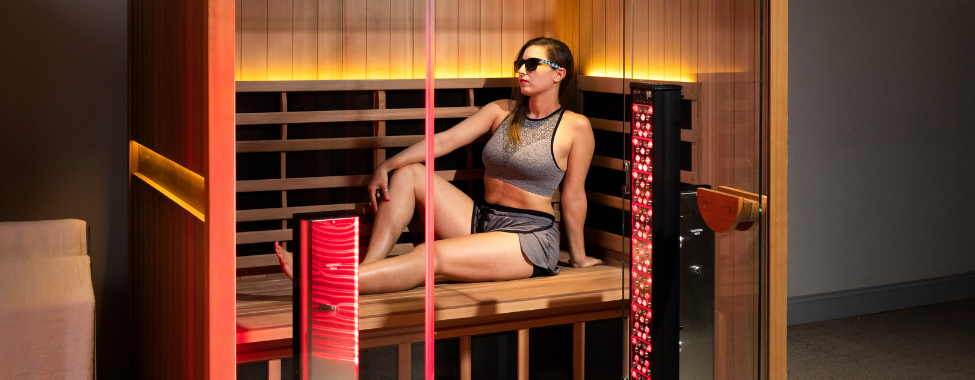- 13 Sep, 2024
- /
- Clearlight Infrared Saunas
- /
- No Comments
Finnish Sauna vs. Infrared Sauna: What’s the Difference?
The health and wellness community seem to agree that spending time in a sauna delivers real, tangible health benefits. Saunas have been used for hundreds of years by communities all over the globe to detoxify and cleanse the body, as well as provide a sense of calm, relaxation, and boosted vitality. From the ancient Finnish tradition of sauna bathing to modern wellness trends, the allure of these heated spaces remains strong. And the science backs it up, too. Researchers from the University of Eastern Finland tracked the weekly sauna usage of 2,300 middle-aged men for an average of 20 years, and found:
- 2-3 times per week = 24% lower all cause mortality
- 4 times per week = 40% lower all cause mortality
- 4-7 times per week = 63% less likely to experience sudden cardiac death
Today, sauna enthusiasts face a choice between two main types: the traditional Finnish sauna and the more modern infrared sauna. While both offer unique benefits, they differ significantly in terms of heat delivery, experience, and potential health benefits. As wellness trends evolve, infrared saunas have gained popularity for their purported benefits and unique characteristics. Let’s explore both options and understand why many health-conscious individuals are gravitating toward infrared saunas over their traditional counterparts.
Traditional Finnish Steam Saunas vs. Infrared Saunas
Temperature Tolerance
If you’ve ever used a Finnish sauna, you’re well aware of the intense heat. Most experts recommend a temperature setting between 180 degrees and 190 degrees Fahrenheit. Throw in a serious dose of humidity and this environment can be quite unmanageable for many of us.
A dry infrared sauna operates differently, producing a therapeutic effect via the infrared waves generated from the heating element, all without the heat and humidity of a Finnish unit. Infrared sauna temperatures usually range from 110 degrees to 140 degrees Fahrenheit, much lower than a traditional Finnish unit. You’ll still produce plenty of cleansing perspiration, but without the discomfort of the oppressive heat of the Finnish design.
Heating Action
Traditional Finnish saunas, like those that have been in use for hundreds of years, incorporate a basic heating design that is simple, yet not as efficient as infrared sauna design. A Finnish design will often draw about 6 kw to maintain its high temperatures, while an infrared sauna draws roughly 1-2 kw of power.
When you consider how long you must preheat the Finnish sauna, which also draws about three times as much energy, it’s obvious the infrared design has won the war on efficiency. The most compelling difference between the two heater designs is the temperature at which they operate. Infrared saunas, as stated earlier, don’t subject the individual to as much heat as the Finnish sauna, therefore enhancing the overall experience.

Space Considerations
If you’ve spent much time looking at the size variances between Finnish saunas and infrared saunas, you’ll probably notice that most infrared saunas can vary in size from small to quite large. Some can be small enough for two people, or may be large enough to practice hot yoga in, but infrared units tend to have a smaller footprint than a traditional sauna – especially if you opt for an even more storable personal sauna dome. The reason being, Finnish saunas tend to devote a lot of space to the actual heating element. This can make them quite ungainly for home use, whereas infrared saunas can fit into many home settings.
Maintenance
Infrared saunas (and their heaters) require almost no maintenance or cleaning upkeep versus the traditional heating elements in a Finnish sauna. Unlike Finnish saunas, infrared saunas don’t employ excessive amounts of heat and steam to create the sweat-inducing environment inside the space.
Finnish saunas generally consume about three times as much energy to operate as an infrared sauna, as they require 45 – 60 minutes to just reach their optimum temperature. Infrared saunas only require a warm up time to allow the infrared heaters to come up to their optimal temperature (usually about 15 minutes). Infrared saunas use about ⅓ of the electrical as compared to a Finnish sauna.
Finnish saunas utilize great quantities of steam and heat to create the sauna effect. This proves to be the perfect breeding ground for bacteria, germs, and mold, all of which pose a greater risk of infection and illness. Infrared saunas, on the other hand, are dry saunas and have been shown to reduce the level of surface contaminants on the sauna bather’s skin, while clearing up blemishes and improving overall complexion.

Sauna Health Benefits
The excessive heat and humidity of a Finnish sauna triggers profound perspiration, which further triggers detoxification and weight loss (though often temporary). An infrared sauna works in a similar fashion, but instead, incorporates IR waves that penetrate the body to raise the core temperature from within. These waves are totally safe, and measure from 6 to 12 microns in wavelength, ideal for absorption by the body. Additionally, infrared units are more efficient at warming the muscles and joints of the body.
Additional Technologies
One of the standout features of infrared saunas is the dry heat environment they provide, which opens up opportunities for integrating additional wellness technologies. Unlike traditional Finnish saunas, where the humidity can limit options, infrared saunas allow for a variety of enhancements that can elevate your sauna session, such as red light therapy towers and salt therapy generators.
These additional technologies can enhance the detoxifying and rejuvenating effects of your sauna experience, making infrared saunas a versatile choice for those looking to optimize their health and wellness routines. Whether you’re seeking muscle relaxation, skin improvement, or respiratory benefits, the integration of red light therapy and salt therapy in your infrared sauna can offer a comprehensive approach to well-being.
Convenience Factor
Undoubtedly, many are fans of the more social aspect of Finnish saunas, as they can sometimes accommodate as many as 10 – 15 people. But there is no denying the convenience of an infrared sauna. You simply turn on the heater and step inside, and there is no need to preheat the sauna. Infrared saunas warm the body from within, therefore, splashing water on heated rocks or managing steam levels is a thing of the past. From a maintenance standpoint, Finnish saunas require preventative measures and vigilant cleaning to keep mold and bacteria at bay. This is not required with an infrared unit.
Adding a Sauna to Your Health Routine
Regardless of whether you choose a traditional or infrared sauna, the health benefits are undeniable, including detoxification, relaxation, and improved cardiovascular health. So when shopping for a sauna, for home or commercial use, definitely consider all the practical applications of a sauna, and know you’ll be setting yourself up for a healthier future. While the iconic Finnish sauna has greater social potential due to its larger sizes, the infrared sauna outranks all other models when it comes to efficiency, affordability, performance, and comfort.
 Canada
Canada Australia
Australia New Zealand
New Zealand Germany
Germany UK
UK EU
EU Ireland
Ireland Malaysia
Malaysia China
China



